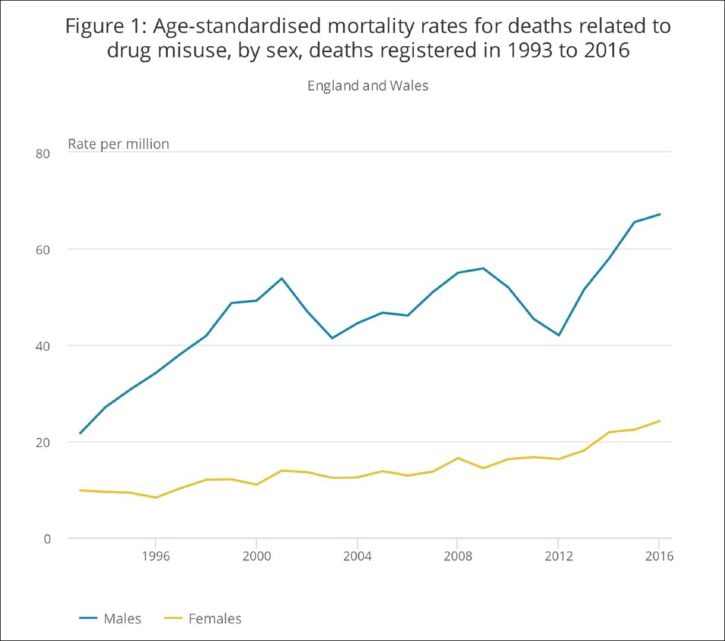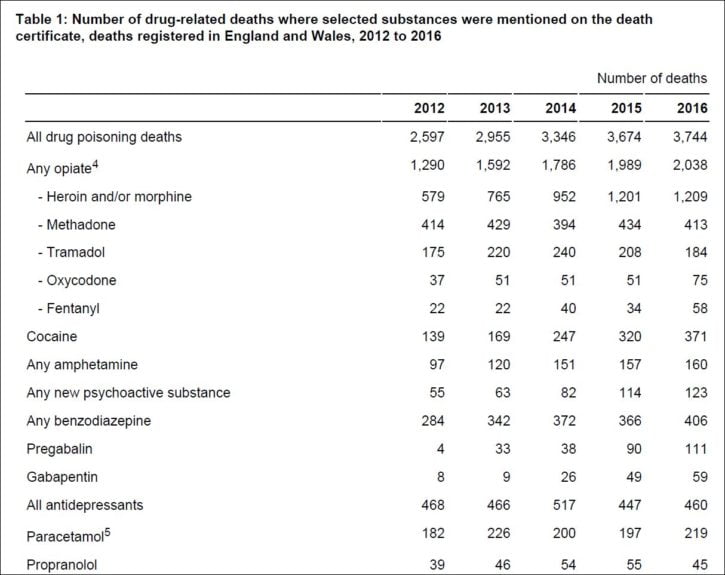3744 deaths registered in 2016
Last week (2 August 2017), the Office of National Statistics published the latest statistical bulletin on Deaths related to drug poisoning in England and Wales in 2016.
They make for sad reading.
Main findings
The headline findings are:
- There were 3,744 drug poisoning deaths involving both legal and illegal drugs in England and Wales registered in 2016; this is 70 higher than 2015 (an increase of 2%) and the highest number since comparable statistics began in 1993.
- Of these 3,744 deaths, 69% (2,593) were drug misuse deaths.
- There has been an increase in the rate of deaths related to drug misuse in Wales from 58.3 deaths per 1 million population in 2015 to 66.9 per 1 million in 2016; deaths in England have remained comparable between 2015 and 2016.
- People aged 40 to 49 years had the highest rate of drug misuse deaths in 2016, overtaking those aged 30 to 39 years.
- Over half (54%) of all deaths related to drug poisoning in 2016 involved an opiate (mainly heroin and/or morphine).
- The highest mortality rate from drug misuse was in the North East with 77.4 deaths per 1 million population, a 13% increase from 2015; the lowest rate (29.1 deaths per 1 million population) was in the East Midlands, which remained stable.
Further details
The dreadful upwards trend of the last four years has continued. In line with previous years, most of the drug-related deaths registered in 2016 in England and Wales were males (2,572 male deaths and 1,172 female deaths). As shown below, the mortality rate for all drug poisoning deaths for males has increased from 51.5 deaths per 1 million population in 1993 to 91.4 deaths per 1 million population in 2016 (a 78% increase). For females, the mortality rate for all drug poisonings has increased from 34.2 deaths per 1 million population in 1993 to 40.6 deaths per 1 million in 2016 (a 19% increase).

As is now, unfortunately, a well-known fact, drug-related deaths are now most common in those aged between 40-49 years, typically older long term drug users with complex needs.

As has been reported in the press, there has been a sharp rise in the number of drug related deaths associated with fentanyl (an extremely potent opiate pain killer) and oxycodone: 
Deaths involving NPS have also increased sharply over the past 5 years, with 123 deaths registered in 2016 (up from 114 deaths registered in 2015 and an 8% increase).
Drug-related deaths have also risen sharply in Scotland (15% higher since 2014 and highest on record) and Northern Ireland (up 30% since 2014). The latest figures from the EMCDDA show that the drug-related mortality rate among adults in the UK (aged 15 to 64 years) was almost three times greater than the average European rate.
Conclusion
The new drug strategy acknowledges the urgent need to tackle the surge in drug-related deaths, but efforts so far have had little impact. This is the fourth annual rise in a row.
Blog posts in the drug and alcohol category are kindly sponsored by Breaking Free Group which has developed a powerful and adaptable digital health platform which targets the underlying psychological and lifestyle factors that drive addictive behaviours. Breaking Free has no editorial influence on the contents of this site.








2 responses
2012 was the year all this Recovery stuff began to drive drug treatment. Retention as an aim in treatment went out of the window and abstinence and discharge became the norm. Commissioners brought in cheaper recovery services at the behest of LAs doing their best to limit overall cuts. Treatment completions measured by an ineffective and silent PHE. Combine this with stronger, newer drugs, some alarming anti-drugs legislation, and it all adds up to disaster. 2012 was the year that The Drug Strategy kicked in, the 2017 refresh means more of the same. We have gone from having one of the best treatment systems in the world to a pared down, unregulated system that kills.
So true, daily in safeguarding children we are seeing the effects of this rise ..most SCR’s are linked with drug misuse the level of accepting’s of parents who use drugs and are still parenting is increasing .. ignoring concerns or any want to changes leading children to being exposed to harm daily going without safe basic care